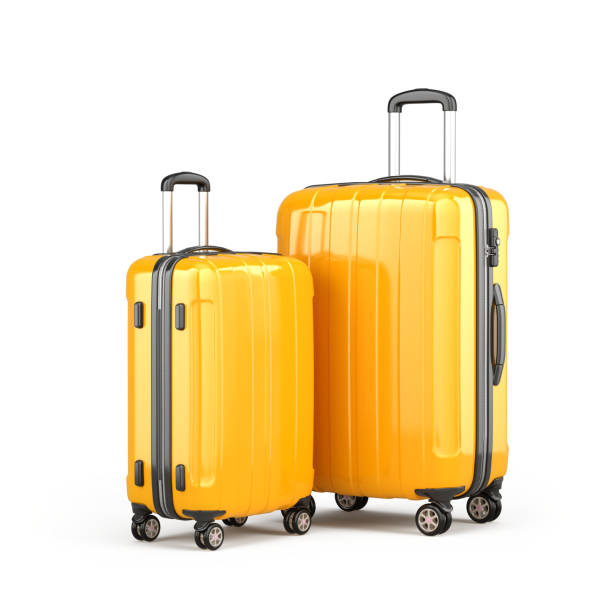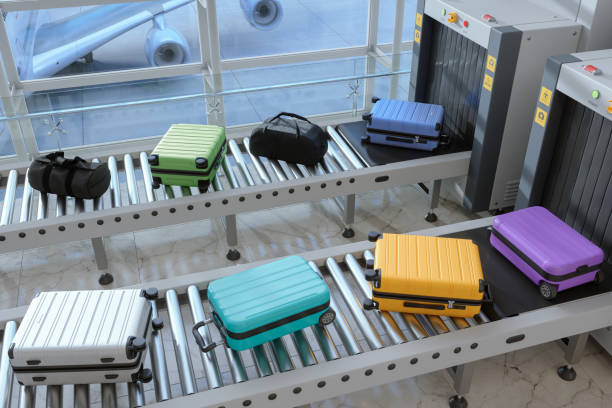Mengetahui ukuran pasti koper Anda sangat penting untuk perjalanan bebas repot, Apakah Anda berkemas untuk perjalanan singkat atau liburan yang diperpanjang. Maskapai memiliki batas ukuran bagasi yang ketat, dan melampaui mereka dapat menyebabkan biaya tambahan.
Panduan komprehensif ini akan memandu Anda melalui mengukur barang bawaan Anda, memahami pembatasan maskapai, dan menjawab pertanyaan umum yang terkait dengan ukuran bagasi.
Mengapa mengukur koper Anda penting?

Hindari kelebihan biaya bagasi
Maskapai penerbangan menegakkan ukuran dan batas berat yang ketat untuk barang bawaan dan barang-barang yang diperiksa. Melampaui batas ini dapat menghasilkan biaya yang besar atau bahkan mengharuskan Anda untuk mengemas ulang di bandara. Dengan mengukur koper Anda sebelumnya, Anda dapat memastikan itu memenuhi persyaratan maskapai dan menghindari biaya tambahan ini.
Pastikan kompatibilitas dengan peraturan maskapai
Maskapai penerbangan yang berbeda memiliki batasan ukuran yang berbeda -beda untuk bagasi. Membiasakan diri dengan dimensi ini dan mengukur koper Anda yang sesuai memastikan proses check-in yang lebih halus dan mengurangi risiko tas Anda ditolak atau dikenakan biaya tambahan.
Mengoptimalkan efisiensi pengemasan
Mengetahui dimensi yang tepat dari koper Anda memungkinkan Anda untuk mengemas dengan lebih efisien, memaksimalkan ruang saat tetap dalam batas ukuran. Ini sangat penting saat menggunakan bagasi yang dapat diperluas, karena overpacking dapat menyebabkan melampaui dimensi yang diizinkan.
Panduan langkah demi langkah untuk mengukur koper Anda

Ukur tinggi
- Posisikan kopernya tegak
Tempatkan koper Anda di permukaan datar di posisi tegak alami.
- Sertakan roda dan pegangan yang tidak dapat di-retractable
Mengukur dari lantai ke titik tertinggi, memastikan Anda memperhitungkan roda dan pegangan tetap apa pun, sebagai maskapai penerbangan memasukkan ini dalam pengukurannya.
- Catat pengukuran
Perhatikan ketinggian dalam inci dan sentimeter untuk fleksibilitas.
Ukur lebarnya
- Letakkan koper datar
Posisikan koper di punggungnya untuk mengakses bagian terluas.
- Ukur di titik terluas
Memperpanjang pita pengukur dari satu sisi ke sisi lain, termasuk pegangan atau tonjolan sisi.
- Mendokumentasikan lebar
Catat pengukuran ini secara akurat.
Ukur kedalaman (Ketebalan)
- Jaga kopernya tetap rata
Mempertahankan posisi koper di punggungnya.
- Ukur dari depan ke belakang
Sertakan kantong eksternal atau kompartemen yang menambah kedalaman.
- Perhatikan pengukuran kedalaman
Ini sangat penting untuk menentukan ukuran keseluruhan.
Hitung inci linier
- Memahami dimensi linier
Maskapai sering digunakan pengukuran linier, yang merupakan jumlah tinggi, lebar, dan kedalaman.
- Lakukan perhitungan
Tambahkan tiga pengukuran bersama -sama. Misalnya, Jika koper Anda mengukur 26 tinggi inci, 18 lebarnya inci, Dan 10 inci kedalaman, inci linier total akan 54 inci.
- Bandingkan dengan batas maskapai
Pastikan total ini tidak melebihi batas inci linier yang ditentukan maskapai untuk bagasi terdaftar.
Pembatasan bagasi maskapai

Barang bawaan
- Dimensi standar
Khas, barang bawaan tidak boleh melebihi 22 tinggi inci, 14 lebarnya inci, Dan 9 inci kedalaman (22x14x9 inci). Namun, Beberapa maskapai mungkin memungkinkan dimensi yang sedikit lebih besar, seperti 22x18x10 inci. Selalu verifikasi dengan maskapai spesifik Anda.
- Batas berat
Ini dapat sangat bervariasi; Periksa kebijakan maskapai Anda untuk menghindari kejutan di gerbang.
Koper yang diperiksa
- Batas inci linier
Sebagian besar maskapai menetapkan maksimal 62 inci linier (157 cm) untuk diperiksa Tas Eva. Ini berarti jumlah tinggi koper Anda, lebar, dan kedalaman tidak boleh melebihi batas ini.
- Pembatasan berat badan
Umumnya, Batas beratnya 50 pound (23 kg) per tas, Tapi ini bisa bervariasi, Apalagi untuk penerbangan internasional.
Barang pribadi
- Batasan ukuran
Barang pribadi harus muat di bawah kursi di depan Anda. Dimensi biasanya tidak boleh melebihi 18 tinggi inci, 14 lebarnya inci, Dan 8 inci kedalaman (18x14x8 inci).
- Contoh
Item seperti dompet, tas laptop, atau ransel kecil biasanya memenuhi syarat sebagai barang pribadi.
Tips untuk pengukuran yang akurat

Sertakan semua fitur eksternal
Selalu mengukur termasuk roda, menangani, dan bagian apa pun yang menonjol, Seperti yang dianggap maskapai penerbangan dalam batasan ukurannya.
Ukur setelah berkemas
Sisi lunak Kasus bagasi dapat berkembang saat dikemas. Ukur koper Anda setelah sepenuhnya dikemas untuk memastikannya tetap sesuai dengan batas ukuran.
Gunakan permukaan yang keras untuk mengukur
Ini memberikan stabilitas dan akurasi selama proses pengukuran.
Periksa kebijakan maskapai
Kebijakan bisa berubah, dan maskapai penerbangan yang berbeda memiliki batasan yang bervariasi. Selalu verifikasi pedoman saat ini sebelum perjalanan Anda.
Tentang Kasus Kinfish
Di pabrik kasing EVA khusus kami, kami mematuhi prosedur produksi sembilan tahap yang ketat dan rumit untuk membuat item Anda. Mulai dari pemilihan bahan yang cermat hingga pemeriksaan kemasan yang cermat, setiap tahap ditangani dengan baik oleh pekerja tertentu. Komitmen kami terhadap keunggulan terlihat pada setiap produk yang kami hasilkan.
Kesimpulan
Mengukur koper Anda secara akurat di rumah adalah tugas langsung namun penting untuk setiap pelancong. Dengan memahami bagaimana mengukur barang bawaan Anda dan menyadari pembatasan maskapai, Anda dapat menghindari biaya yang tidak terduga dan memastikan pengalaman perjalanan yang lebih halus.
Selalu luangkan waktu untuk mengukur tas yang dikemas dan berkonsultasi dengan pedoman khusus maskapai Anda untuk tetap patuh dan bepergian dengan ketenangan pikiran.
FAQ
1. Berapa ukuran tas bagasi 23kg?
Koper yang mengakomodasi 23 kg (50 lbs) umumnya dianggap sebagai tas yang diperiksa menengah hingga besar. Dimensi khas untuk bagasi seperti itu ada 26 ke 30 tinggi inci, 18 lebarnya inci, Dan 10 inci kedalaman.
Namun, Sangat penting untuk memastikan bahwa dimensi linier total tidak melebihi batas maskapai penerbangan, biasanya 62 inci.
2. Berapa ukurannya Bagasi Internasional?
Pembatasan ukuran bagasi internasional dapat bervariasi dengan maskapai dan tujuan. Umumnya:
Koper yang diperiksa: Maksimal 62 inci linier (157 cm) Dan 50 pound (23 kg) dalam berat.
Barang bawaan: Dimensi sering ditutup pada 22x14x9 inci, Tetapi beberapa maskapai mungkin mengizinkan hingga 22x18x10 inci. Batas berat dapat berkisar dari 15 ke 22 pound (7 ke 10 kg).
Selalu periksa pedoman maskapai tertentu sebelum bepergian secara internasional.
3. Berapa ukuran barang bawaan yang dapat dibawa naik pesawat terbang?
Sebagian besar maskapai penerbangan mengizinkan barang bawaan dengan dimensi maksimum 22 tinggi inci, 14 lebarnya inci, Dan 9 inci kedalaman. Namun, Beberapa maskapai mungkin memungkinkan ukuran yang sedikit lebih besar, seperti 22x18x10 inci.
Sangat penting untuk mengonfirmasi dengan maskapai Anda, Karena dimensi ini dapat mengakibatkan harus memeriksa tas Anda di gerbang.
















